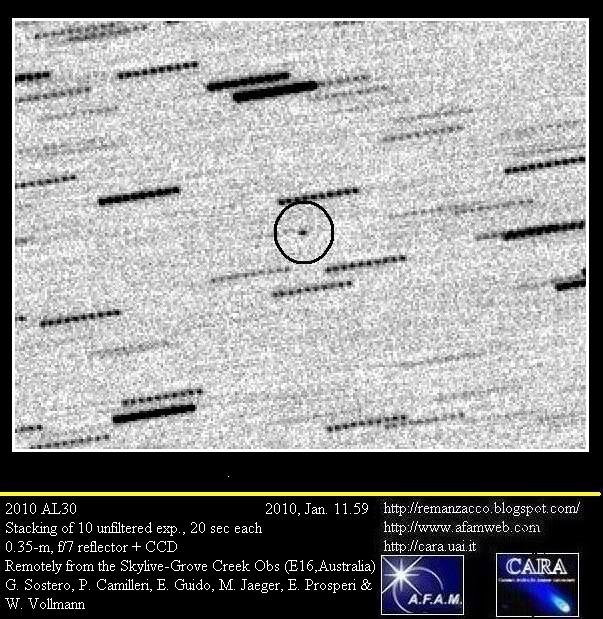[/caption]
Caption: Asteroid or rocket booster? 2010 AL30 as imaged remotely from Australia on Jan. 11, 2010. Credit: Ernesto Guido & Giovanni Sostero, Remanzacco Observatory.
An unusual object will make a close flyby of Earth on Wednesday, coming within only 128,000 km (about 80,000 miles), or at a distance about three times less than the moon’s orbit. The object, named 2010 AL30, is about 10-15 meters long, and asteroid watchers say there is no chance it will hit the planet. But is it an asteroid or perhaps a piece of space junk, like a spent rocket booster?
UPDATE: The Solar System Dynamics website now says the object is an Apollo-type asteroid, which are Near-Earth asteroids that have orbits which cross the Earth’s orbit and pass approximately 1 AU or less from Earth.
According to Italian astronomers Ernesto Guido and Giovanni Sostero of the Remanzacco Observatory, who took this image (above) of 2010 AL30, it has an orbital period of almost exactly one year and might be a man-made object.
However, Alan Harris, senior researcher at the Space Science Institute said the object has a perfectly ordinary Earth-crossing orbit.
“Unlikely to be artificial, its orbit doesn’t resemble any useful spacecraft trajectory, and its encounter velocity with Earth is not unusually low,” he said.
The object make its closest approach at 12:48 GMT on Wednesday, and and amateur astronomers are encouraged to observe 2010 AL30 as a 14th magnitude star in the constellations of Orion, Taurus, and Pisces. Check here to get the ephemeris of the object from the Solar System Dynamics website.
Several observatories, including the Goldstone Radar will be observing NEO 2010 AL30 during its Earth flyby. After the January 13 close flyby, it will go too close to the Sun to be observed.
Sources: Remanzacco Observatory, Spaceweather.com


A spent rocket booster at 128,000 km? Seems unlikely to me…
INCOMING! Got hardhats and gold undies? LOL!
Good to see that someone’s watching… disconcerting to realize the short notice?
@Silenus why not? 10 m object is not so big for a rocket booster. It could also be some Russian forgotten sattelite.
If i am not mistaken, 10m would be quite large for an object that once escaped earths gravity. Not to mention that it would only barely escape, seemingly not going anywhere.
I wager it is natural.
@Excalibur:
These objects are typically not resolvable and thus an estimate of their size is derived from their brightness (absolute magnitude). In order for this to work one has assume one knows what material they are made of and thus what their albedo is, and the typical assumption is that they are a dark asteroid. If instead the object’s surface is a highly reflective metal or white paint, it might be reflecting a lot more light than one would expect, leading one to overestimate its size. It might be a lot smaller than 10 m….
…except the Solar System Dynamics website says it is an asteroid, so presumably they’ve been able to identify the material using multispectral analysis.
Three times less than the moons orbit? UH
Any chance this is a spent third stage from an old Saturn 5 rocket? The Apollo 4, 6, 8, 10, 11 and 12 third stages were injected into solar orbits. The Apollo 13, 14, 15, 16 and 17 third stages were smashed into the Moon to create artifical moonquakes. I remember reading the Apollo 12 third stage made a close pass to Earth about six years ago.
“or at a distance about three times less than the moon’s orbit.” – Perhaps you mean one third of the Moon’s orbital distance from Earth?
“Several observatories, including the Goldstone Radar will be observing NEO 2010 AL30 during its Earth flyby”
Why are there no reports, pictures … from these observations yet?
Seems an employee of ESA (Michael Kahn) has put forth the possibility that this is a Fregat upper stage from the Soyuz vehicle that launched the Venus Express probe in 2005. Details at: http://www.scilogs.eu/en/blog/go-for-launch/2010-01-12/close-asteroid-encounter-tomorrow . Guess we might know soon enough.
A short movie of the object (and a passing satellite) taken by an amateur astronomer is posted over at SpaceWeather.com, where I also found the Venus Express link.